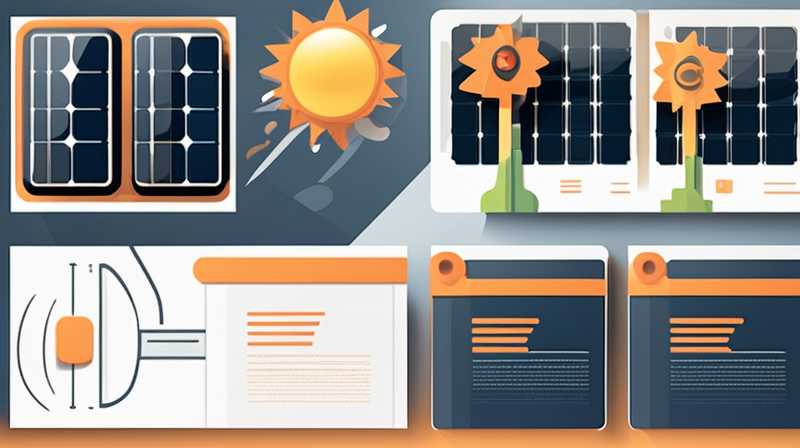
1. IDENTIFYING YOUR ENERGY NEEDS:
2. CONSIDERING LOCATION AND ENVIRONMENT:
3. UNDERSTANDING SYSTEM COMPONENTS:
4. BUDGETING AND FINANCING OPTIONS:
5. INSTALLATION METHODS:
6. MAINTENANCE REQUIREMENTS:
FREQUENTLY ASKED QUESTIONS
WHAT TYPES OF SOLAR POWER SYSTEMS ARE AVAILABLE FOR OUTDOOR USE?
Solar power systems suitable for outdoor applications typically encompass a variety of options, including grid-tied, off-grid, and hybrid systems. A grid-tied solar system connects directly to the electrical grid, allowing users to sell excess energy back to the utility company, thus maximizing financial savings. These systems work well for households or businesses situated near power lines, offering a reliable source of energy without the need for battery storage. On the other hand, off-grid solar power systems are completely independent from the electrical grid. They require batteries to store energy for use during non-sunny periods, making them ideal for remote locations where connection to a grid is impractical. Lastly, hybrid systems combine both grid-tied and off-grid functionalities, offering flexibility and redundancy in energy supply and ensuring that users can tap into the grid when necessary or rely on stored energy at other times.
HOW LONG DOES A SOLAR POWER SYSTEM LAST?
The longevity of a solar power system is dependent upon several factors, including the quality of components, installation practices, and environmental conditions. Generally, solar panels are designed to last between 25 and 30 years, with most manufacturers offering warranties that guarantee performance over this timeframe. However, certain factors can influence efficiency and lifespan. For example, harsh weather conditions, such as hail, heavy snow, or extreme temperatures can impact the durability of panels. Moreover, regular maintenance, including cleaning panels and checking electrical connections, can significantly extend the operational life of a system. It is also crucial to monitor the performance of inverters, as they typically have a shorter lifespan compared to solar panels, requiring replacement every 5 to 15 years. To ensure maximum effectiveness and durability, having a professional inspection at regular intervals is advised.
WHAT FACTORS AFFECT SOLAR POWER EFFICIENCY IN OUTDOOR SETTINGS?
The efficiency of solar power systems in outdoor scenarios can be influenced by various elements. Sun exposure is one of the most critical determinants, as solar panels require direct sunlight to generate electricity effectively. The geographical location, time of year, and local weather conditions can all affect the amount of sun a specific area receives. Additionally, shading from trees, buildings, or other objects can significantly hinder performance, as even partial shading can lead to substantial energy losses. Another significant factor is the angle and orientation of solar panels; panels facing south at a tilt appropriate for the latitude of the installation site typically yield the most energy. Furthermore, technological advances such as using bifacial panels which capture light from both sides can enhance efficiency. Lastly, the quality of the installation—the placement and wiring—can also greatly influence how effectively the solar energy is harnessed.
BOLD CONCLUSION:
In summary, selecting the optimal solar power design for outdoor applications involves a multifaceted evaluation of energy requirements, site characteristics, component knowledge, budget considerations, installation methods, and maintenance obligations. Ensuring a comprehensive evaluation and adherence to best practices will not only streamline the decision-making process but also maximize the operating efficiency and longevity of the solar power system. The initial step involves a thorough analysis of energy needs, ensuring that the selected system can sustainably meet these demands without straining resources or financial capabilities. Considering environmental factors is paramount; the geographical location and potential shading can drastically alter system performance, necessitating a careful site evaluation. Knowledge about each component of the solar power system, from panels to inverters to mounting systems, empowers consumers to select high-quality materials suitable for unique outdoor conditions. Financial considerations, including installation costs and potential incentives or rebates available, can heavily influence the choice of solar technology.
An understanding of installation nuances, whether handled through professional services or DIY approaches, is essential in guaranteeing functional reliability. Continuous and proactive maintenance, while often overlooked, must be planned and implemented strategically to preserve the system’s efficacy over its lifespan. Each of these dimensions intertwines to create a comprehensive framework for successful solar power deployment outdoors. Therefore, consumers are encouraged to undertake detailed research, possibly consult with experts, and remain abreast of advancements in solar technology. By doing so, one not only embraces sustainability but also fosters long-term energy independence, affording greater control over energy production, costs, and reducing reliance on non-renewable energy sources.
Original article by NenPower, If reposted, please credit the source: https://nenpower.com/blog/how-to-choose-solar-power-outdoors/


